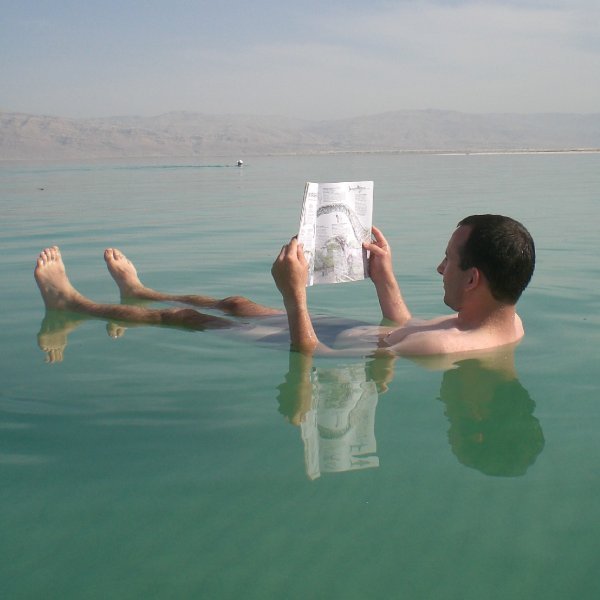Dead Sea, Jordan. One of the most spectacular natural and spiritual landscapes in the whole world, the lowest point on earth, and the world's richest source ...
www.atlastours.net/jordan/deadsea.html
Dead Sea - Wikipedia, the free encyclopedia
Dead Sea at dawn (from Sodom mountain, Israel). Dead Sea at dusk (from Suwayma, Jordan). Sinkholes at Mineral Beach. Dead Sea from Masada ...
Etymology - Geography - Natural history - Climate
en.wikipedia.org/wiki/Dead_Sea
Dead Sea | Vote7
The Dead Sea is a salt lake between Palestine and Israel to the west and Jordan to the east. At 420 metres below sea level, its shores are the lowest point ...
www.vote7.com/n7w/nature/finalists/dead-sea

http://ianaloni.wordpress.com/2009/03/06/20-photos-of-israel/
Dead Sea Israel Jordan
The Dead Sea (Hebrew: יָם הַמֶּלַח, Yām Ha-Melaḥ, "Sea of Salt"; Arabic: البَحْر المَيّت, al-Baḥr El-Mayyit, "Dead Sea"), also called the Salt Sea, is a salt lake in Jordan to the east and in the West Bank and Israel to the west. Its surface and shores are 422 metres (1,385 ft) below sea level,[2] the lowest elevation on the Earth's surface on dry land. The Dead Sea is 378 m (1,240 ft) deep, the deepest hypersaline lake in the world. It is also one of the world's saltiest bodies of water, with 33.7% salinity. Only Lake Assal (Djibouti), Garabogazköl and some hypersaline lakes of the McMurdo Dry Valleys in Antarctica (such as Don Juan Pond and perhaps Lake Vanda) have a higher salinity. It is 8.6 times more salty than the ocean.[3] This salinity makes for a harsh environment where animals cannot flourish, hence its name. The Dead Sea is 67 kilometres (42 mi) long and 18 kilometres (11 mi) wide at its widest point. It lies in the Jordan Rift Valley, and its main tributary is the Jordan River.
The Dead Sea has attracted visitors from around the Mediterranean basin for thousands of years. Biblically, it was a place of refuge for King David. It was one of the world's first health resorts (for Herod the Great), and it has been the supplier of a wide variety of products, from balms for Egyptian mummification to potash for fertilizers. People also use the salt and the minerals from the Dead Sea to create cosmetics and herbal sachets.
The Dead Sea is an endorheic lake located in the Jordan Rift Valley, a geographic feature formed by the Dead Sea Transform (DST). This left lateral-moving transform fault lies along the tectonic plate boundary between the African Plate and the Arabian Plate. It runs between the East Anatolian Fault zone in Turkey and the northern end of the Red Sea Rift offshore of the southern tip of Sinai.
The Jordan River is the only major water source flowing into the Dead Sea, although there are small perennial springs under and around the Dead Sea, creating pools and quicksand pits along the edges.[6] There are no outlet streams.
Rainfall is scarcely 100 mm (3.9 in) per year in the northern part of the Dead Sea and barely 50 mm (2.0 in) in the southern part. The Dead Sea zone's aridity is due to the rainshadow effect of the Judean Hills. The highlands east of the Dead Sea receive more rainfall than the Dead Sea itself.
To the west of the Dead Sea, the Judean Hills rise less steeply, and are much lower, than the mountains to the east. Along the southwestern side of the lake is a 210 m (690 ft) tall halite formation called "Mount Sodom".
http://en.wikipedia.org/wiki/Dead_Sea




